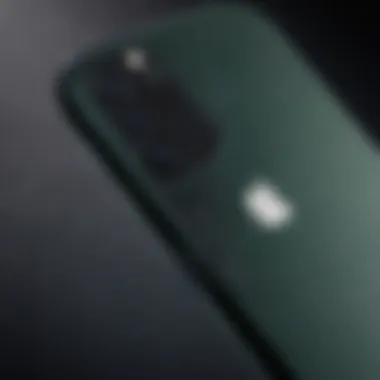Analyzing iPhone 11 Pricing: Key Influencers


Overview
Prolusion to the topic of the article
Understanding the price of the new iPhone 11 is a crucial element for anyone considering its purchase. With technology advancing rapidly, the price of gadgets like smartphones can often leave potential buyers scratching their heads in confusion. Not every prospective customer is well-versed in what determines these prices. From storage options to market dynamics, various aspects play pivotal roles in shaping the pricing structure of devices like the iPhone 11.
Brief background information
Apple has long been a prominent player in the smartphone market, innovating not only in technology but in how they sell their products. The iPhone 11, released amid fierce competition, is positioned to attract buyers with its blend of features and performance, but understanding its pricing is equally vital. The company employs a pricing strategy that takes into account consumer expectations, retail markups, and the overall market conditions. Thus, exploring this topic can provide invaluable insights to consumers aiming to navigate their purchasing decisions effectively.
Features & Specifications
When discussing the iPhone 11, it’s impossible to overlook its standout features and specifications that may influence its price:
- Display: The device comes with a 6.1-inch Liquid Retina HD display, providing stunning visuals.
- Camera: Equipped with a dual 12MP camera system, a night mode functionality stands out, which allows users to capture detailed low-light photos.
- Performance: Powered by Apple's A13 Bionic chip, performance is swift and efficient.
- Battery Life: Users can expect longer battery life, with up to 17 hours of video playback.
- Storage Options: Available in 64GB, 128GB, and 256GB, affecting the pricing hierarchy.
These features capture the essence of the device, but their impact on pricing is equally notable, as higher-capacity models tend to have higher price tags.
Pros and Cons
Analyzing the advantages and disadvantages can provide further clarity on whether the iPhone 11 is worth the investment:
Pros:
- High-quality camera capabilities
- Robust performance and speed
- User-friendly interface
- Solid battery performance
- Apple ecosystem compatibility
Cons:
- The absence of 5G support
- Premium pricing compared to competitors
- No expandable storage options
This breakdown highlights how buyers can weigh the value of the iPhone 11 against its cost, allowing for a more informed decision.
User Experience
User impressions largely influence the perceived value of a device like the iPhone 11. Here are a couple of insights from customer reviews:
"The camera alone makes it worth it for me. The night mode is a game-changer!"
"I expect more from a flagship device in 2020. The absence of 5G feels outdated already."
Such sentiments summarize the mixed experiences users have with the product, showcasing both admiration for its features and disappointment in certain areas lacking contemporary technology.
Buying Guide
When considering a buyer's guide for the iPhone 11, several points surface:
- Budget: Assess how much one is willing to spend, particularly since prices vary by retailer and storage options.
- Carrier Deals: Look out for promotional products from carriers. Sometimes they offer better pricing when combined with contract plans.
- Storage Needs: Choose the storage capacity that fits better; higher storage equals higher price.
- Timing: Prices may vary based on sales events, so it’s worth keeping an eye on seasonal promotions, particularly around holidays.
Navigating through these points can lead to a more rewarding purchase experience, allowing one to feel satisfied with both the choice and the price paid for the iPhone 11.


Preface to iPhone Pricing
Pricing is more than just a number when it comes to gadgets, it's like the heartbeat of the market, especially for a device as influential as the iPhone 11. Understanding the pricing structure is crucial, not just for tech enthusiasts who keep an eagle eye on the latest features but also for daily consumers who want value for their dollars. With devices getting pricier and the competition stiffening, knowing the ins and outs of iPhone 11 pricing can make the difference between a sound investment and buyer's remorse.
Apple's iPhone line has often set the benchmark for pricing in the smartphone sector. The iPhone 11, with its slew of features and technological advancements, is no exception. It's imperative to grasp how various elements—like design, storage capacity, and even retailer strategies—play a role in the final cost. More so, understanding these factors can guide consumers in making choices that align with their personal or financial needs.
Overview of iPhone Features
Before diving into pricing, it's essential to outline what you're getting for your money. The iPhone 11 comes packed with distinct features:
- Dual-camera system: The notable upgrade with ultra-wide capabilities opens new avenues for photography enthusiasts.
- Liquid Retina HD display: This makes colors pop and provides a viewing experience that's hard to beat.
- A13 Bionic chip: Regarded as one of the fastest chips in a smartphone, offering a seamless user experience, whether gaming or multitasking.
- Long battery life: Averaging up to 17 hours in talk time, it can last the day without needing a refill.
These features come together to create an appealing package, driving consumer demand—and subsequently, the price.
The Importance of Pricing in Tech Purchases
Price is a potent motivator in purchasing decisions. In tech, it often signals quality and features. Consumers look at the iPhone 11's price not just as a cost but as a reflection of the innovation behind the product. Pricing often dictates how desirable a gadget is perceived; a premium price tag may foster a sense of exclusivity.
Furthermore, knowing the ins and outs of pricing can inform purchasing actions:
- Budget management: Helps in understanding what you can afford, ensuring you don't stretch beyond your means.
- Comparison shopping: Identifying what others are charging enables savvy buyers to snag the best deal.
- Anticipating discounts: Understanding pricing trends can also signal when to wait for sales, enhancing value for money.
"The price tag can influence consumer perception as much as it impacts their wallets.
In summary, as we explore the facets of iPhone 11 pricing, from its features to strategic marketing, it's essential for readers to appreciate the significance of informed purchasing in today's tech-driven world.
Base Prices Across Models
When it comes to understanding the iPhone 11 pricing landscape, one can't overlook the importance of base prices across models. This aspect serves as a foundational point for potential buyers, allowing them to gauge what they might expect to shell out based on their preferences regarding model choice and associated features. The pricing not only reflects various specifications but also feeds into consumers' psychological triggers— how much they perceive value versus expense.
More than just numbers on a price tag, these base prices establish a baseline for buyer expectations. The variations in pricing signal differences in capabilities, which can alter a customers' decision-making process and influence their loyalty to the brand.
Standard Pricing for Different Models
Apple generally rolls out several different models with each new iPhone release, each priced to cater to different audience segments. For the iPhone 11, the standard lineup presents three primary models: the iPhone 11, the iPhone 11 Pro, and the iPhone 11 Pro Max. Each of these models comes with distinct features, thereby reflecting a diverse pricing strategy.
For instance, the iPhone 11 boasts of a dual-camera setup, offering a balance for budget-conscious consumers who still seek premium experience. It usually starts at a lower price point compared to its Pro counterparts.
In contrast, the iPhone 11 Pro and iPhone 11 Pro Max cater to those who regard advanced features such as superior camera performance and enhanced display quality as pivotal. Consequently, these models command a higher price, often making them appealing to consumers who prioritize high-end functionalities or professional-grade photo capabilities.
Storage Options and Their Costs
Once you've selected the model that suits your needs, the next consideration becomes storage. The iPhone 11, for example, typically offers options that range from 64GB to 256GB. Each tier naturally comes with its own price tag, reflecting how much data you anticipate needing over the device's life. A larger capacity may seem tempting, especially for those who enjoy streaming, gaming, or storing a treasure trove of photos and videos.
It's important to weigh the additional costs against what you realistically need.
- 64GB is great for casual users who mostly rely on cloud services.
- 128GB caters well for those who capture lots of pictures without worrying about storage space.
- 256GB is primarily for users who want everything on their device and may regularly download apps and other large files.
Given the nature of technology where each software update demand more storage, one can argue that shelling out extra cash on storage might translate into longer usability of the device.


Ultimately, navigating through the array of models and their respective base prices sheds light on how the iPhone pricing ecosystem functions. It enables consumers to make wiser choices without veering off course in a market that continually innovates and challenges the status quo.
Retail Pricing Strategies
In the world of technology, how a product is priced can tell you a lot about its market position and consumer appeal. When it comes to the iPhone 11, the strategies behind its retail pricing are critical for understanding its place in the broader smartphone ecosystem. Different retailers employ diverse tactics to entice buyers, and the prices you see can vary wildly depending on where and how you shop.
Price disparities often arise from a variety of factors, including competition, regional differences, and promotional strategies. Retailers may adjust their pricing strategies based on the market demand, seasonal sales, and their own inventory levels. This can create advantages for consumers who take the time to do their research, but it can also lead to confusion on the part of buyers who might not understand these complexities. Thus, retailers not only serve as conduits for sales but also become integral players in shaping how much consumers eventually pay for the iPhone 11.
Price Disparities Between Retailers
Not all retailers are created equal when it comes to pricing the iPhone 11. There can be noticeable differences in price between brick-and-mortar stores, online retailers, and even different locations within the same brand.
- Outlet Stores vs. Flagship Stores: Outlet stores may offer lower prices to clear older stock, while flagship stores might maintain higher prices due to their brand positioning and experience.
- Online vs. In-store Pricing: E-commerce platforms often provide discounts or special offers that a physical store might not match, making it crucial to compare online listings.
- Authorized vs. Unofficial Retailers: Authorized sellers typically adhere to pricing guidelines set by Apple, while unofficial retailers might be more flexible, leading to potential savings but also risks, like warranty issues.
For example, an iPhone 11 purchased at Best Buy might be $50 cheaper than the same model at an Apple Store. Several online marketplaces, such as Amazon or eBay, can also have shifting prices based on demand. Watching for these fluctuations and understanding that they aren’t random can spell a significant difference in cost.
Influence of Purchase Locations
Where you choose to buy your iPhone 11 can have profound effects on the price you pay. The store’s location, its affiliation with carriers, and any local promotions can vary widely. Purchasing from a large chain retailer that has regular sales or bundling options might mean a better deal than going through a smaller electronics store.
Consider the following points:
- Carrier Locations: Buying through a carrier often comes with options for installment payments or plans that could lower upfront costs. However, these plans can tie you into multiyear contracts.
- Local Promotions: Some areas might have localized sales that reflect regional buying power or seasonal demand. A retailer in a high-tech metropolitan area might run promotions for tech-savvy buyers to boost sales.
- Availability of Trade-Ins: Certain stores might allow trade-ins for older devices, effectively reducing the cost of the new iPhone 11 significantly.
It's imperative for consumers to be savvy about their choice of purchase locations. Even within the same city, prices can diverge due to local retailers' pricing strategies.
In summary, retail pricing strategies for the iPhone 11 are complex, influenced by the myriad of retailer practices, local market dynamics, and consumer behavior. By understanding these nuances, buyers can leverage their purchasing power effectively to secure the best deals.
Discounts and Promotions
Discounts and promotions play a pivotal role in shaping the pricing landscape of the iPhone 11, making it essential for potential buyers to understand their significance. Often, these financial incentives can mean the difference between splurging on a phone and grabbing one at a more palatable price. In the competitive world of tech, retailers, and carriers frequently tempt consumers with enticing offers that can lessen the initial sting of purchasing a new device. Moreover, understanding when and where to find these promotions can lead to substantial savings, enabling savvy shoppers to make informed decisions.
Seasonal Sales Impacting iPhone Pricing
Seasonal sales are a great time for consumers to snag attractive discounts on iPhone 11 models. Events like Black Friday, Cyber Monday, and back-to-school sales often see retailers slashing prices to attract buyers. For instance, during Black Friday, many popular retailers might offer bundles along with the iPhone 11 at reduced rates, including accessories such as AirPods or cases.
In other instances, during holidays such as the end-of-year celebrations, retailers create special promotions that can provide significant savings on select models. Keeping an eye on these events can help potential buyers land a worthwhile deal. Staying informed through websites like reddit.com or tech news sites can also yield alerts for upcoming sales and promotions, acting as a handy guide for price-conscious shoppers.
Carrier Deals and Their Implications
Carrier deals can also heavily influence the pricing structure of the iPhone 11. Often, major carriers present their own promotions, sometimes offering the iPhone at a steep discount in exchange for a service contract. While this might appear advantageous, it’s crucial to read the fine print. For example, some deals might involve paying a larger fee over time, effectively countering any initial savings. Additionally, these contracts may bind consumers for several years, creating a decision that some might wish they hadn't made.
Furthermore, trades or upgrades can drastically change the final pricing a buyer sees. Carriers typically provide incentives if one trades in an older model as part of the purchase. This could dramatically reduce the financial outlay required to acquire the iPhone 11. In essence, understanding the specifics of carrier deals, including the fine print on contracts and trade-in offers, can empower consumers to navigate potentially complex purchasing scenarios.
The savvy buyer is often the one who does their homework, especially when it comes to seasonal sales and carrier promotions.
Market Trends Affecting iPhone Prices


Understanding the market trends that influence iPhone prices is crucial for both consumers and tech enthusiasts alike. With smartphones being a significant investment in today’s digital age, knowing the factors that can affect pricing will empower buyers to make more informed decisions. Whether it’s economic shifts or changes in consumer preferences, these trends can significantly sway the market.
Economic Conditions and Consumer Behavior
Economic conditions often play a pivotal role in the pricing of technology devices like the iPhone 11. When the economy is booming, consumers tend to spend more freely on goods, including high-end smartphones. They might consider features, brand loyalty, and the latest innovations more important than the price tag. In these scenarios, Apple may have room to raise prices without scaring off buyers.
Conversely, during a recession, the dynamics shift dramatically. People become cautious about their spending, focusing on the essentials rather than the latest gadgets. This behavior can lead to reduced sales for high-tier electronics, prompting retailers to offer discounts or special financing options to entice buyers. According to a recent survey on consumer spending habits, there’s a clear correlation between disposable income levels and purchasing decisions related to luxury tech products, like the iPhone.
A study pointed out that during economic downturns, brands that offer value for money tend to thrive, as consumers look for better deals.
Comparative Pricing with Competitors
When evaluating iPhone prices, it’s also essential to consider how they stack up against competing brands. Apple has positioned itself as a premium brand, and its pricing reflects that philosophy. However, rival companies like Samsung and Google often adjust their prices based on Apple’s launches and marketing strategies. For instance, when Apple releases a new iPhone model, competitors might reduce the prices of their existing models to capture market share.
Moreover, the emergence of budget-friendly devices poses another challenge for Apple. For customers seeking affordability, brands like OnePlus or Motorola might seem more appealing due to their lower price points. This competitive pricing landscape forces Apple to keep an eye on its rivals' strategies.
- Consumer Expectations: Buyers expect to get a certain level of quality and functionality at different price ranges. If a competitor offers comparable features at a lower price, that could have a ripple effect on iPhone pricing.
- Market Saturation: In a saturated market, companies tend to engage in price wars to attract consumers. This can push Apple to reconsider its pricing strategy.
In summary, understanding market trends affecting iPhone prices involves closely watching economic conditions and evaluating competitive dynamics. By grasping these elements, consumers can better navigate their purchasing decisions and find the best value for their money.
Understanding Warranty and Insurance Costs
When considering the purchase of a new iPhone 11, understanding warranty and insurance costs is crucial. Many consumers overlook these expenses, thinking only about the upfront price of the device. However, a deeper insight into warranty coverage and potential insurance can save a substantial amount of money in the long run. These costs provide a safety net for your investment, allowing you to navigate unforeseen circumstances that could damage or compromise the functionality of your smartphone.
The implications of choosing between warranty and insurance can directly impact your overall ownership experience. For instance, a standard warranty typically covers manufacturing defects, but it may not encompass accidental damage. This gap often leads consumers to seek insurance options that address such vulnerabilities. Therefore, understanding both avenues equips buyers with the knowledge necessary to protect their assets effectively.
Standard Warranty Pricing Breakdown
The standard warranty period for the iPhone 11 generally extends for one year from the date of purchase. This warranty, backed by Apple, ensures that any mechanical failures not caused by misuse are repaired at no additional cost. Consumers can rest easy, knowing that they have a solid layer of protection.
However, as beneficial as it is, the standard warranty does have its limitations. For instance, it does not cover issues arising from accidental drops, water damage, or loss. Knowing these limitations can influence your decision on whether to seek further insurance coverage.
Pricing for warranty services can sometimes vary. For example, if you opt for AppleCare+, the protection extends for an additional year on top of the standard warranty and includes coverage for two incidents of accidental damage, although a service fee will apply for repairs. This additional layer of protection might set you back around $199. Is it worth it? That depends on how often you find yourself in situations where accidents may happen.
Insurance Options and Related Fees
Beyond the standard warranty, various insurance plans are available to further shield your iPhone from potential mishaps. Insurance plans can be acquired through third-party companies or through your carrier. These options usually cover theft, loss, and a broader set of damages compared to a standard warranty.
When considering insurance, it’s essential to evaluate the premiums charged, which can differ greatly based on the plan and provider. For example, a plan from a well-known third-party provider may range from $10 to $15 monthly.
Here are some key points to consider regarding insurance:
- Coverage Scope: Ensure the coverage addresses accidents, theft, and more.
- Deductibles: Some plans require deductibles that can vary significantly, thus impacting the cost-effectiveness of the insurance in the long run.
- Claim Limits: Be aware of any caps on the number of claims you can file per time frame.
Choosing the right warranty and insurance setup can ultimately provide peace of mind, allowing users to enjoy their new iPhone 11 without the constant worries about potential mishaps. Overall, weighing the costs against the potential benefits is a wise strategy for any informed consumer.
Culmination
Key Takeaways on iPhone Pricing
- Base Models and Upgrades: The base pricing gives a solid starting point, but it's the upgrades in storage and features that can significantly alter the final cost. For example, an entry-level iPhone 11 starts reasonably, yet opting for increased storage turns it into a more substantial investment.
- Variability in Retail Prices: Don’t settle for the first price you see. Retailers often implement differing pricing strategies, which means that comparing prices across various outlets can yield better deals.
- Seasonal Offers: Be wary of the seasonal sales; they can drastically change the pricing landscape. Keeping an eye on these can lead to well-timed purchases where significant savings are concerned.
"Understanding price isn't just about saving dollars; it's also about understanding value."
Guidance for Potential Buyers
When contemplating the purchase of an iPhone 11, consider these strategic guidelines:
- Research Thorough: Prior to making your move, dive into multiple sources to gather data on the pricing of different models. Websites such as en.wikipedia.org or reddit.com may provide firsthand experiences from other consumers, showcasing their purchasing journey.
- Weigh the Long-Term Costs: It's easy to get caught up in the sticker price, but think about the total cost of ownership. For instance, warranty and insurance costs can add up over time, potentially offsetting initial savings.
- Evaluate Carrier Options: Carrier deals can be enticing, yet be cautious. They often come with contracts that might not serve you best in the long run. Perusing through contract terms found on sites like facebook.com could be beneficial.
- Timing is Key: If your current phone isn't on its deathbed, wait for optimal purchasing times. Launch events or holiday seasons can present golden opportunities for discounts and bundles.







